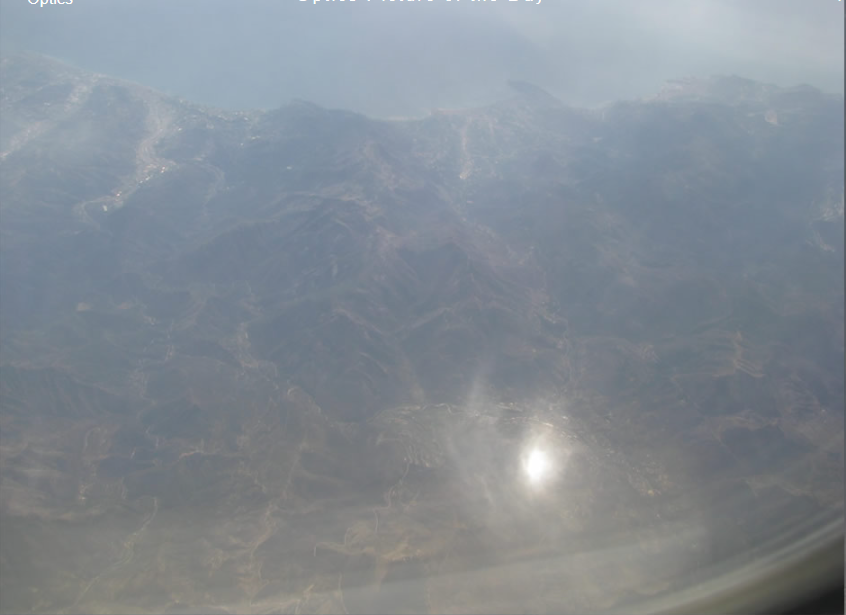OPOD - Italian Subsun
OPOD - Italian Subsun: A Captivating Atmospheric Phenomenon
The Italian Subsun is a captivating atmospheric optical phenomenon that has been beautifully captured by Alessia Boscolo Nata near the Tirrenian coast between Liguria and France. This remarkable image showcases the stunning reflection of the sun on the nearly horizontal hexagonal faces of plate-shaped ice crystals present in the clouds. With its blinding brightness, the subsun is easily distinguishable from surface water reflections. It drifts across the landscape beneath, moving with the motion of the aircraft, providing a mesmerizing spectacle.
Unveiling the Nature of Subsuns
Subsuns, also known as sun dogs or parhelia, are direct reflections of the sun created by the interaction of sunlight with ice crystals in the atmosphere. These ice crystals are typically found in cirrus clouds, which are composed of thin, wispy strands or patches of ice crystals. The hexagonal shape of these ice crystals plays a crucial role in producing the subsun phenomenon. As sunlight passes through these hexagonal crystals, it is refracted and reflected, resulting in the formation of a subsun.
Differentiating Subsuns from Surface Reflections
One key characteristic that distinguishes subsuns from surface reflections is their movement across the landscape below. While surface reflections remain stationary, subsuns drift along with the motion of the aircraft. This dynamic nature allows observers to identify subsuns and appreciate their ethereal beauty. In Alessia's photograph, we can observe this distinct feature as the subsun glides above the cirrus layer, with smaller and sharper reflections visible from a river and pools far below.
The Enigmatic Bottlinger's Rings
Upon careful examination of subsuns, one might have the fortune of spotting a rare and mysterious phenomenon known as Bottlinger's rings. These peculiar rings appear as concentric circles surrounding the subsun and add an extra layer of intrigue to the already fascinating display. The exact cause of Bottlinger's rings is still not fully understood, leaving scientists and enthusiasts captivated by their enigmatic nature. Further research and observations are needed to shed light on the mechanisms behind the formation of these intriguing features.
Curved Tails: An Unexplained Phenomenon
In addition to Bottlinger's rings, subsuns occasionally exhibit another puzzling characteristic: curved tails. These curved tails appear as elongated streaks extending from the subsun, curving in various directions. Despite extensive study and observation, the exact cause of these curved tails remains a mystery. Scientists continue to investigate this phenomenon in the hopes of unraveling its underlying mechanisms. The presence of curved tails adds an element of unpredictability and fascination to the already captivating world of subsuns.
Exploring the Italian Subsun
Alessia Boscolo Nata's photograph of the Italian Subsun offers a glimpse into the awe-inspiring beauty of this atmospheric phenomenon. The image was captured while traveling on the sunward side of an airplane, positioned above a cirrostratus layer. This vantage point allowed Alessia to discern that the subsun was not a mere reflection from the window or surface lakes. Instead, it revealed the intricate play of light and ice crystals that gave rise to this mesmerizing spectacle.
Delving into Atmospheric Optics
Atmospheric optics encompasses a diverse range of optical phenomena that occur in Earth's atmosphere. These phenomena result from the interaction of sunlight with atmospheric particles such as ice crystals, water droplets, dust, and pollutants. From rainbows and halos to mirages and iridescence, atmospheric optics provides a captivating glimpse into the interplay between light and the atmosphere. Subsuns, with their stunning reflections and intriguing characteristics, are a prime example of the wonders that can be observed within this field of study.
Embracing the Beauty of Nature's Miracles
The Italian Subsun serves as a reminder of the astounding beauty that surrounds us, even in the most unexpected places. By taking a moment to appreciate and understand atmospheric phenomena like subsuns, we gain a deeper appreciation for the intricacies of our natural world. These captivating displays of light and color offer us a glimpse into the hidden wonders that exist just beyond our everyday perception. So, next time you find yourself gazing at the sky, keep an eye out for the elusive subsun, and let yourself be captivated by the enchanting dance of light and ice crystals in the atmosphere.

Italian Subsun ~ Imaged by Alessia Boscolo Nata near the Tirrenian coast between Liguria and France. ©Alessia Boscolo Nata, shown with permission.

".. When I saw the 'subsun' I was traveling on the sunward side of the airplane, above a cirrostratus layer, and this fact was important for me to realize that was not a reflection from the window or lakes on the surface."
Subsuns are direct reflections of the sun from the nearly horizontal hexagonal faces of plate-shaped ice crystals in clouds.
They can be blindingly bright. They are easily distinguished from surface water reflections because they drift across the landscape beneath with the motion of the aircraft. The large view of Alessia's subsun shows some much smaller and sharper reflections from a river and pools far below the cirrus layer.
Look at subsuns carefully - you might spot the rare Bottlinger's rings or they might show currently unexplained curved tails.
Note: this article has been automatically converted from the old site and may not appear as intended. You can find the original article here.
Reference Atmospheric Optics
If you use any of the definitions, information, or data presented on Atmospheric Optics, please copy the link or reference below to properly credit us as the reference source. Thank you!
-
<a href="https://atoptics.co.uk/blog/opod-italian-subsun/">OPOD - Italian Subsun</a>
-
"OPOD - Italian Subsun". Atmospheric Optics. Accessed on December 25, 2024. https://atoptics.co.uk/blog/opod-italian-subsun/.
-
"OPOD - Italian Subsun". Atmospheric Optics, https://atoptics.co.uk/blog/opod-italian-subsun/. Accessed 25 December, 2024
-
OPOD - Italian Subsun. Atmospheric Optics. Retrieved from https://atoptics.co.uk/blog/opod-italian-subsun/.